
Loudspeaker drivers are reciprocal transducers. Their main task is transforming an electrical (audio) signal to a mechanical force, then to a sound wave. In the opposite direction, any change in the acoustic or mechanical domains is reflected in the electrical input impedance of the driver. Therefore, a driver can also be used as a sensor to investigate the features of the enclosure in which it operates.
Beginning with the classical description of loudspeakers as equivalent electrical circuits, Roberto will show how this idea can be applied to practical cases, consider the level of accuracy that can be achieved, and discuss additional insights that can be gained from the peaks in the impedance graph of a loudspeaker system.
Roberto Magalotti is Principal Research Engineer at the Southwater Research and Engineering lab of Bowers & Wilkins (UK). He graduated in Physics at the University of Bologna in Italy in 1994, with a thesis on the physical modelling of musical instruments. After graduation, he worked for some years as a designer of professional loudspeaker systems, specialising in crossover networks, loudspeaker horns, and plane wave tube measurements. In 2001 he joined B&C Speakers (Italy), a leading company in the design and manufacturing of professional loudspeaker drivers. There he became Head of Research in 2008, before joining Bowers & Wilkins in 2019. His interests include modelling, measurement, and simulation of the nonlinear behaviour of loudspeaker drivers, optimization of magnetic assemblies, application of Finite Elements Analysis to loudspeaker design, and low frequency room acoustics. He teaches courses on loudspeaker technology at Le Mans Université. Roberto has been a Member of the Audio Engineering Society since 1998, and served as Secretary of the Italian Section from 2005 to 2007.
Please follow this link for Zoom registration.